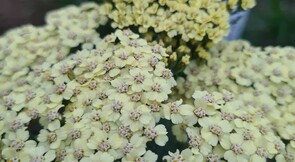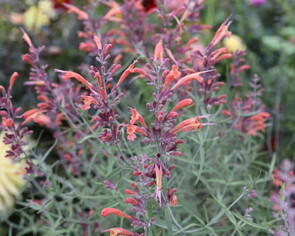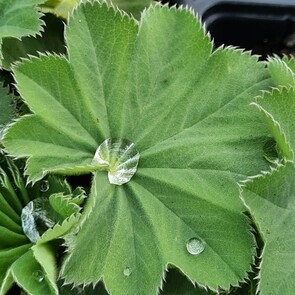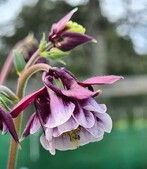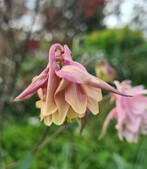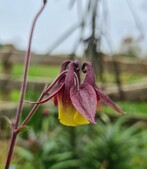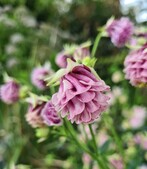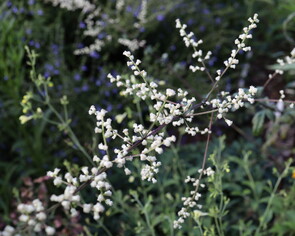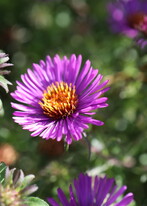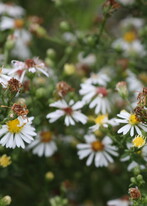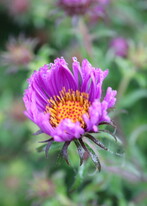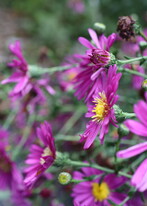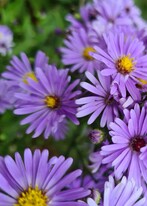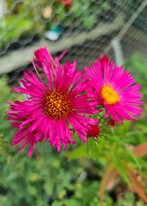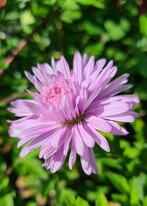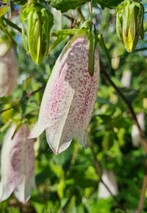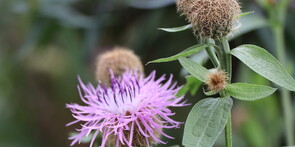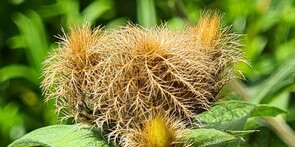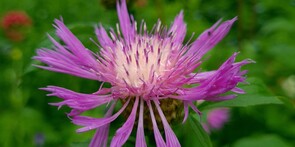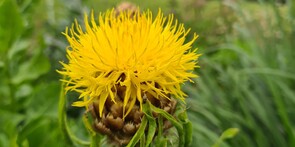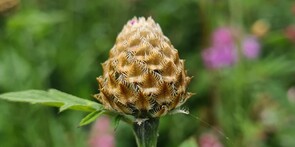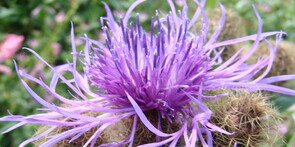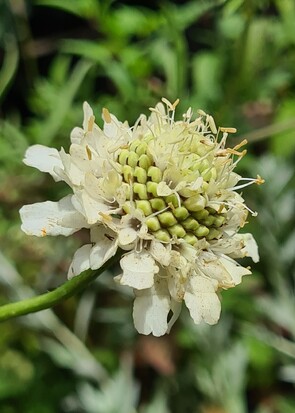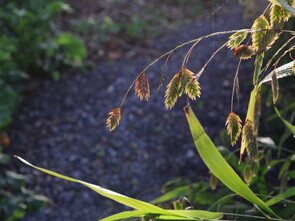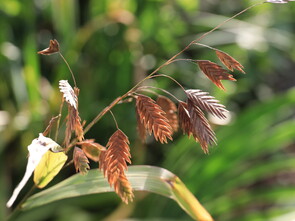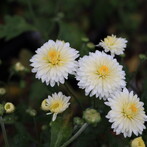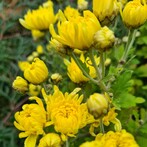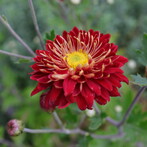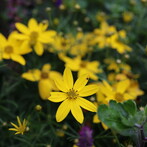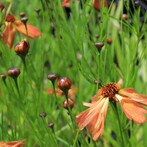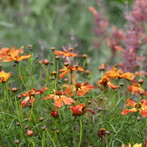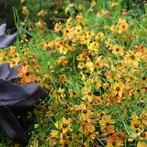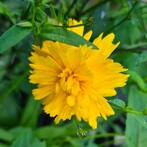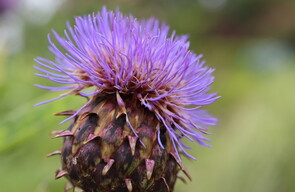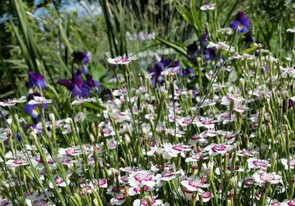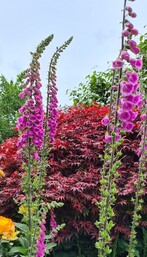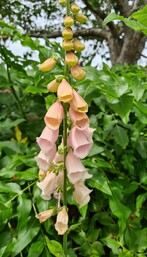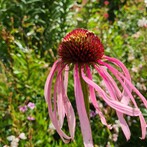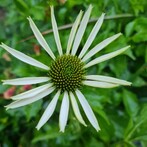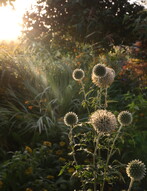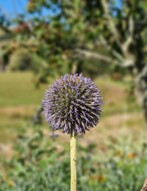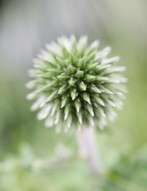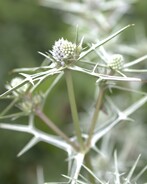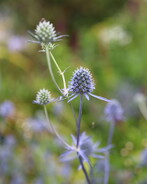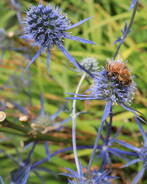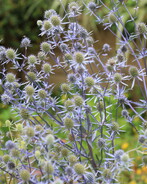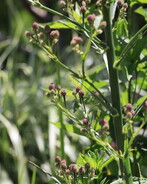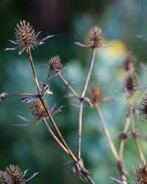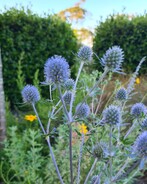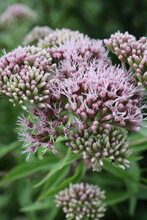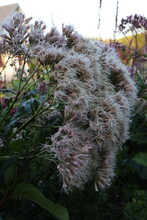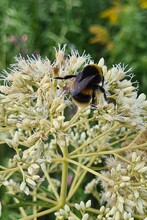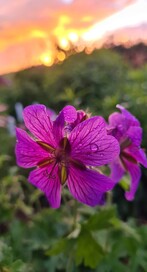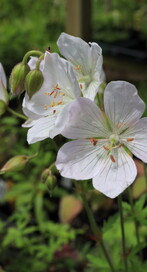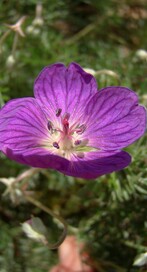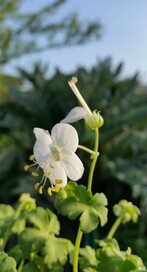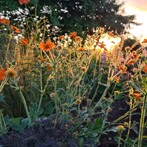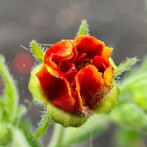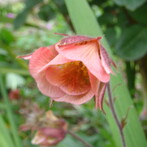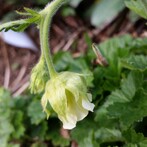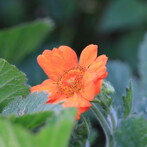Work in progress....
Under development
Welcome to the Perennial Plants Library
The purpose of this library is to provide a database of information about the various perennials I grow for you to refer back to as you please. The information is based on observations and working with these plants in my garden (based in the Waikato, New Zealand) along with my own readings and discoveries from various books and websites.
Achillea
Achillea are sun loving perennials that provide a wonderful burst of colour from late spring through summer and into the autumn. They are from the Asteraceae family, their inflorescence is known as a corymb, a fairly flat topped flowerhead made up of many smaller flowers, the flowers colour fades and changes as they age. Their fern-like, feathery foliage forms clumps and can spread its self along but I have never found it to be invasive. In some literature they have talked about the unreliability of Achillea with it being short lived but in my experience all the plants I have put in, provided I have given them ample sunshine (those in shadier spots have not thrived) are all still growing strong.
Achillea do not like to sit in wet heavy soil and need plenty of sunshine - it copes well in dry conditions, take care that their basal leaves are not being shaded by more dominating plants. Dead head regularly by cutting back the flowering stem at the base to prolong the flowering season. These plants are very popular with bees and beneficial insects and are a great cut flower, harvest when 75-80% of the flowers are open on the stem.
Propagation: Achillea are easy to divide in spring and summer and clumps respond well to division every 2-3 years. Can be grown from seed, particularly A. millefolium, resulting in some lovely pastel colour variations.
Planting Combinations: Achillea work well with many other sun loving perennials - Salvias, Agastache and Monarda - where their dome flowerheads contrast against the other perennial flower shapes. They also can contrast against the bold foliage of Cannas or Aoeniums or complement a wispy planting of grasses, particularly Anemanthele lessoniana.
Achillea (also known as Yarrow) that I grow in the garden and may have available through the nursery are:
A. filipendulina Parkers Variety: Upright stems but can tend to flop over a bit, 1m+, clump forming, bright yellow flowerheads. Looks fantastic planted next to Salvia 'Amistad'.
A. ptarmica The Pearl: Dark green leaves, copes with some shade and damper soils; Loose flowerheads of small white button flowers, floppy stems.
A. millefolium Various types including Terracotta; Cerise Queen; The Beacon; Lavender and Lace; Lemon; Red Shades; Anthea and many varieties that I have selected from seed grown plants here in the nursery and have grown on.
Agastache
Agastache are sun loving plants from the Lamiaceae family, best known for their aromatic foliage. There are two distinct groups of Agastache. The taller group include A. foeniculum, A. nepetoides and A. rugosa. These Agastache form bushy bold plants with strong stems and dense flower spikes. The other group come from hotter, drier climates and include A rupestris, A. aurantiaca, A. cana and A. mexicana. Their flower whorls are more spaced out and they usually have woody bases and these agastache can be more short lived. Agastache are loved by bees and beneficial insects.
Agastache prefer well drained, fertile soil in full sun. A.rugosa can tolerate damper soil. Reasonably hardy but a prolonged wet winter could prove more harmful than a cold one.
Propagation: Agastache can be grown from seed sown in spring or from stem cuttings taken late spring/summer.
Planting Combinations: I have had fun combining Agastaches with the strappy foliage of Kniphofia or Tulbaghia or grasses. The colours of A.rupetris 'Apache Sunset' looked stunning over summer next to the purple/magenta tones of Verbena rigida. Or you can use the larger growing Agastache to make a bold summer-autumn flower dominated display by pairing with Monarda, Heliopsis, Salvias and Dahlias.
Agastache that I have growing in the garden and may have available in the nursery are:
A. aurantiaca: Various types I have grown include Sunset Yellow, Fragrant Orange and Fragrant Yellow, Raspberry Daiquiri. These agastache have small grey-green leaves, reach 30-40cm high. Can be easy to get swamped by other plants so place at the front.
A. 'Heather Queen': This one has triangular leaves of dark green with a touch of crimson underneath; pinkish-purple flowers. Reaching up to 80cm.
A. mexicana 'Sangria': Deciduous with creeping stems, toothed green leaves and rose-pink flowers.
A. rugosa: Erect stems and coarsely toothed scented leaves with a grey underside. Reaches 80cm - 1m. Bushy growth.
A. rupestris 'Apache Sunset': Woody based, slender stems with grey toned fine leaves and salmon-orange flower spikes, 50-60cm tall.
Alchemilla
Alchemilla (Lady's Mantle) is from the Rosaceae family. A fantastic ground cover plant with interesting scalloped leaves and loose sprays of greenish yellow flower heads. It forms a dense clump and can grow in full sun and in shadier conditions and is tolerant of most soil types. Alchemilla play a wonderful role in my garden on the edges of beds as well as underplantings with other larger perennials due to their ability to cope with the shade these other perennials may cast over them through the growing season. They appreciate a tidy up of dead leaves and they can seed around the garden but I have never found them to be evasive in my garden and regular dead-heading can prevent unwanted seedlings emerging. Their flowers from late spring into summer add wonderful green tones to bouquets and the leaves magically hold droplets of water for fantastic photo opportunities. Cut flower stems off at the base of the plant.
Propagation: Division of clumps from spring into summer and they can also be grown from seed.
Planting Combinations: I find that the Alchemilla can be used in many planting combos in the garden. They look fantastic next to Borago pygmaea or Stachys byzantina (Lambs ear). They can be grown under roses or provide a foliage contrast next to airy Gaura or strappy grasses or Kniphofia.
Alchemilla that I have growing in the garden and may have available in the nursery are:
A. erythropoda: A more compact form, blue-green leaves and yellowish-green flowers. 15-30cm.
A. mollis: The well known Lady's Mantle, densely packed deep green lobed leaves; long stems of yellow-green flowers. 30-60cm. 'Thriller' is a cultivar often grown that has flowers grown in a more spreading plume.
Aquilegia
Aquilegia, also known as Granny's Bonnet or Columbine, are a classic cottage garden plant and a favourite of mine in the garden. These cheerful flowers bring joy to the spring/summer garden. There are about 70 species of Aquilegia but many of the ones we encounter in our garden are Aquilegia vulgaris. They have soft blue-green lacy foliage and the flowers are held up on strong stems at varying heights depending on the species. There are various doubles available alongside dainty alpine varieties. Aquilegia are recognised by their nectar laden spurs that extend backwards between the sepals although there are many spurless cultivars too. They self seed freely in the garden. I cut back or pull out those that I don't want to let seed around and let those of a colour or flower shape that I like drop their seed.
Aquilegia can grow in full sun or part shade. They seem to cope in a variety of soils here - popping up in gravel, poor soil and in rich well drained loam. They work well as a cut flower, harvest when one-third of the flowers on the stem have opened and before they start dropping their petals. Vase life of 6-8 days.
Propagation: Aquilegia are best propagated from seed that is collected when ripe in summer and sown then or sown in the spring. They can tend to be short lived plants (2-3 years) in some areas but with allowing self-sowing, my garden has never been without them.
Planting Combinations: Aquilegia work beautifully with a number of other perennials. In my garden they intermingle with the likes of Anthriscus sylvestris 'Ravenswing', Campanula, Bearded Iris, Roses, Euphorbia, Verbena, Geums and Lilies.
Aquilegia that I have growing in the garden and may have available in the nursery include:
A. flabellata var. pumila 'Selection': dainty, short spurred with bright blue flowers with white tipped petals, 15-20cm.
A. vulgaris var. stellata 'Black Barlow': Dark plum-purple coloured double flowers, 75cm tall.
A. vulgaris: Various doubles from seed selected from the garden.
A. chrysantha 'Yellow Star': tall, elegant yellow toned flowers with long spurs.
Artemisia
Artemisia are from the Asteraceae family and include a large range of evergreen or deciduous shrubs and perennials. I enjoy Artemisia lactiflora in the garden and it is a bit different to the other Artemisia. It is a clump forming deciduous perennial that enjoys full sun/part shade and moist soil, doesn't like to dry out in summer. Reaching heights of 1 - 1.5m + with its airy clouds of tiny flowers held up on strong stems.
Propagation: Division or basal cuttings in spring.
Planting Combinations: Artemisia lactiflora is an easy plant to combine with others with its see-through stems and delicate flowers. I use it with Rudbeckia, Helenium, Gaura, Dahlias, Lilies, Heliopsis, Salvias and various grasses.
Artemisia that I have growing in the garden and may have available in the nursery include:
A. lactiflora: This form I have had for a number of years, it has a purplish tinge to the stems and foliage and the flowers are white.
A. lactiflora Rosenschleier: Has a pinkish tinge to the flowers.
Aster
Asters are from the Asteraceae family and are also known as Michaelmas Daisies. Recently they have been reclassified after scientific work revealed that there are distinct differences in generic structure of the plants under the name Aster, thus the introduction of Symphyotrichum and Eurybia in their names. These name changes have been difficult for the majority of us to take on board so I have continued to place these perennials in the library under their common name of Aster for ease of use.
Aster are loved by bees and beneficial insects and although they have a bit of a dull existence with their green clumps of foliage through spring and early summer they make up for it with their flower power come late summer and into autumn. With some flowering stems reaching over 1m+ and being covered in numerous small daisy-like flowers they create a stunning picture. I admit to loving Asters, with well over 30 different types in my garden, I can't help myself if I see another one that I haven't got yet.
Asters like well drained soil but don't appreciate drying out over summer. Some of the A. novi-belgii types can suffer from mildew in a warm damp summer. For cut flowers, pick when one-quarter of the flowers on the stem have opened. Some Asters can be particularly vigorous spreaders so take care when placing in the garden if putting them next to more delicate plants as they may be overwhelmed - A. laevis Calliope is a strong grower in my garden but I have it planted with Rudbeckia and Eupatorium that both can handle it's vigour.
Propagation: Can be grown from seed. Easy from division or basal cuttings in spring.
Planting Combinations: Pair with the late flowering perennials and grasses - Miscanthus, Calamagrostis, Rudbeckia, Eupatorium, Solidago, Vernonia, Veronicas, Heleniums, Salvias, Helianthus. Or contrast their delicate flower masses against foliage of Phormium or Cannas or Astelia.
Aster (Symphyotrichum) that I grow in the garden or may have available in the nursery include:
Symphyotrichum Coombe Fishacre, clump forming, pink-mauve flowers, 80-90cm on stems that arch out sideways.
Symphyotrichum ericoides I have both pink and white varieties, multiple small flowers on strong stems, 1m+
Symphyotrichum laevis 'Calliope': Light purple flower, vigorous spreading growth. 1m+
Symphyotrichum lateriflorus var. Horizontalis: Bushy growth, horizontal stems bear white flowers with purple-red centres., 50-60cm tall.
Symphyotrichum 'Little Carlow': Fantastic grower, clump forming, flowerheads of lavender blue flowers. Strong stems.
Symphyotrichum novae-angliae (New England Aster) Strong stems with green to grey-green foliage, coarse hairs on foliage. Benefit from dividing clump every 2-3 years. Types include: Andenken an Alma Potschke; Harrington's Pink; Herbstschnee; September Ruby, Violetta along with some seed grown of my own in lovely shades of violet/purple and pink.
Symphyotrichum novi-belgii (New York Aster): Medium to dark green foliage, clump forming. Types include: Hi Jinx, Erica, Winston S Churchill, Fellowship, Helen Ballard, Jeannie, Albanian and more.
Calamagrostis
Calamagrostis are a perennial grass from the Poaceae family. With dense clumps of strappy leaves and upright slender stems through summer and into autumn these are an easy care grass to add to the garden. They seem to cope in a variety of soils and growing conditions here, from dry poor soil to deep loam. I trim them back to just above ground level in late winter. The wonderful thing with these grasses is they don't tend to flop apart like the Miscanthus do, they keep themselves much more upright. Ornamental grasses can add a great textural element to cut flower arrangements.
Propagation: Divide clumps in Spring.
Planting Combinations: There are never ending planting combinations for these grasses. Calamagrostis x acutiflora 'Karl Foerster' makes a bold statement in the garden and I have this paired with the likes of Persicaria amplesicaulis 'Firetail', Monarda, tall growing Salvias, Rudbeckia, Heleniums, Helianthus and Asters. But it also works wonderfully next large foliage plants such as Cardoons and Cannas. Calamagrostis x acutiflora 'Overdam' has a more delicate framework and I use that one next to Veronicas, smaller Salvias, delicate Sisyrinchium and Epimediums.
Calamagrostis that I have growing in the garden and may have available in the nursery include:
C. x acutiflora 'Karl Foerster': Can reach up to 2m tall, dense clump of green strappy foliage that emerges from late winter/early spring. Fine, tall stems are topped with soft brown flowers.
C. x acutiflora 'Overdam': Reaching up to 90cm tall with cream stripes in the leaves and the flowers have a slight pinkish tinge.
Campanula
This is a large, diverse group of plants belonging to the Campanulaceae family. Also known as the Bellflower, the green foliage can often be heart-shaped or toothed and some species can be very vigorous growers. Their flowers are the classic bell shape and flower colours range from white to pink to various shades of blue/purple. Some are deciduous, others maintain a groundcover appearance through winter before flowers emerge in spring. Campanulas provide that classic cottage garden look but they aren't a plant I would give centre stage as they don't have a long season of interest but they do enhance the flowering display in late spring/summer.
Propagation: Campanulas can be grown from seed, from basal cuttings taken in spring or from division.
Planting Combinations: Campanulas blend in with many other plants in the garden, Roses, Daylilies, Geums, Alchemilla, Potentilla, Geranium to name a few. But take caution with the more vigorous types as they can be hard to remove once they take a hold.
Campanula that I have growing in the garden and may have available in the nursery include:
C.cochlearifolia 'Advance White': This little groundcover spreads but without the vigour of some of the other types. The gorgeous dainty white bells arrive in late spring. 10-15cm.
C. glomerata: The clustered bellflower is a very vigorous grower, I have mine planted in a bed with ground cover violets and the two can battle it out together. I do love its dark purple flowers that emerge on strong stems in summer. Seems to cope with some shade.
C. makaschvilii: This campanula has been slow to establish but I love its delicate creamy white flowers with a slight hint of pink that appear on long spreading stems. Clump forming.
C. persicifolia: A clump forming plant, copes in poor soil. Has tall stems of purple flowers (there are white forms too).
C. poscharskyana: Easy going plant for sun or part shade, creates a mound of light green leaves and has light purply-blue flowers on delicate stems 20-30cm.
C. punctata: Vigorous spreaders. If you have a spot in the garden where this can just do it's thing without become a hindrance then go for it. I have mine planted under deciduous trees and another planted on a hot dry bank. Both seem to be surviving in these varied growing conditions. There bell shaped flowers always bring a smile.
C. takesimana 'Elizabeth' Another vigorous spreader but lovely delicate pink bell flowers.
Centaurea
Centaurea (Knapweed) are from the Asteraceae family. They cope well in poor soil and are often associated with meadow, naturalistic plantings. The composite flower is made up of a number of individual flowers held together by a calyx, often these scaly bracts provide a textural element to the garden. The majority flower from late spring into summer. Enjoying full sun and well drained soil. They seem to be rather robust, handling the hustle and bustle of mixed planting in my garden.
Propagation: Some types are easy to grow from seed, others you can divide in spring or take basal cuttings.
Planting Companions: Centaurea work well in a variety of planting schemes, complementing various other perennials such as Geraniums, Silene and Kniphofia. I also enjoy using them with various grasses such as Anemanthele lessoniana, Calamagrostis or Carex.
Centaurea that I have growing in the garden and may have available in the nursery include:
C. dealbata: Persian Cornflower. Light grey-green leaves, mauve-pink flowers with a white centre 50-60cm.
C. jacea: Brown Knapweed. Medium green foliage, long stems with mauve-pink flowers. 1-1.5m
C. macrocephala: Giant Knapweed. Green leaves with bold strong stems bearing buds of brown papery scales and a golden yellow flower head. 1-1.2m.
C. nigra: Black or Common Knapweed. Purple flowers and dark bracts.
C. montana: This was the first Centaurea I remember seeing in a garden, I loved its blue-purple flowers and grey green leaves. They can seed around the garden. There is also a white and a pink form.
C. phrygia: Wig Knapweed. I love the buds of this one (see top two Centaurea photos) 40-70cm.
Cephalaria
Cephalaria were noted as being from the Dipsacaceae family but now come under the Caprifoliaceae family which includes scabious, valerian and teasels. Cephalaria are an airy delicate addition to the garden, a tall yet see-through plant that I love to include in various planting schemes. They grow well in full sun and may cope with some shade. Well drained soil.
Propagation: Grown from seed or division in spring of established plants.
Planting Combinations: These plants are tall so they work wonderfully with other tall perennials - Calamagrostis, Rudbeckia, Helianthus, Heleniums, Eupatorium, Sanguisorba, tall Salvias etc.
Cephalaria that I have growing in the garden and may have available in the nursery include:
C. gigantea: The Giant scabious can reach up to 2m with delicate lemon yellow scabious type flowers.
C. radiata: Very similar to C. gigantea but slightly shorter and less upright habit. 1.5m.
Chasmanthium
Chasmanthium is from the Poaceae family and commonly known as Northern Sea Oats or Wood Oats and native to USA and Mexico. It is a clump forming, deciduous grass with wonderfully textural seed heads that hold their form well into the winter. In my garden they are growing in full sun and part shade, seem to cope with poor soil and even summer drought or very wet conditions doesn't seem to bother them. They do set seed but are easy to pull out if they have placed themselves in an unwanted position.
Propagation: Division in spring or from seed.
Planting combinations: Very versatile, I have them combined with Sanguisorba, Daylilies, Salvia, Gaura, Roses, Dahlias, Sedums and Leucanthemum.
Chasmanthium that I have growing in the garden and may have available in the nursery include:
C. latifolium: reaches 70-90cm
Chrysanthemum
Chrysanthemums are a wonderful later flowering perennial from the Asteraceae family that add a burst of colour and fun to the garden. Majority of them flower in autumn but there are a few that provide flowers from summer right through the autumn. Winter dormant, their foliage emerges come spring - sometimes the slugs and snails make quite a feast of this emerging foliage. The taller varieties would require staking unless you are happy to let them flop around and grow as they please which is what occurs in my garden. Full sun, well drained soil. Fantastic cut flower - in early summer cut back the growth to 15-20cm (use the pieces you cut back for cuttings!). This cutting back encourages branching growth and more flowers.
Propagation: Basal cuttings in spring, stem cuttings through the growing season or division in early spring as the foliage begins to emerge.
Planting Combinations The Chrysanthemums make a wonderful display with the other late flower perennials - Salvias and Dahlias, Miscanthus and Cannas.
Chrysanthemums I grow in the garden and may have available in the nursery include:
Orange Bronze pompom - this little beauty is my favourite, long flowering season from summer onwards, holds itself, reaching 30-50cm. Bright orange/bronze pompom flowers.
Red Flair: flowering late in the season, red blooms with a gold dusted beige colour under the petal, very tall.
Kelvin Mandarin: Tangerine orange tight flowers, very tall.
Feeling Green: Lime Green to yellow green, tight flowers, very tall.
The list goes on and on...Red Fairy, Salmon Fairy, Salmon Anemone, Crimson Anemone, Diana Stokes, Sussex White, Cream Patricia Millar, Jean Patton, Dusky Queen, Peter Fraser, Gold Cassandra, Carillion Sunshine Yellow, Lemon Yellow, Full Pink, Kiwi Magic............
Coreopsis
Coreopsis (also known as Tickseed) are from the Asteraceae family and are a bright addition to the garden with their daisy like flowers. Most Coreopsis prefer full sun, consistent moisture but in well-drained soil. Make sure Coreopsis with low basal foliage aren't overshadowed by larger perennials resulting in a lack of sun to the plant. The grandiflora types have large bright yellow flowers, some with a hint of burgundy or mahogany, they are often a short lived perennial so take basal cuttings to grow more plants on. The verticillata types are usually longer lived with delicate foliage emerging in spring. Regular deadheading of Coreopsis will give a long flowering season.
Propagation: Divide clumps in spring or take basal cuttings. Some cultivars can also be grown from seed and will often bloom in their first year.
Planting Combinations: The bright yellow grandiflora types I have combined with Hostas, Achillea, Carex and Agastache. The verticillata types have small delicate foliage and flowers and you need to make sure they aren't crowded out so choose other clumping perennials such as small Euphorbia, Helianthemum, Tulbhagia, Sedums or Agastache aurantiaca, Anthriscus sylvestris, Salvia nemorosa and dwarf Kniphofia as companions.
Coreopsis I grow in the garden and may have available in the nursery include:
C. grandiflora 'Early Sunrise': semi-double yellow flowers, jagged edge to the petals. 40cm - 45cm tall.
Coreopsis hybrid 'Mango Punch': I love the orange/peachy tone of these flowers, a herbaceous perennial, delicate foliage emerging in spring and producing many flowers. Can be short lived.
C. verticillata "Moonbeam": Delicate lemon flowers 30-50cm.
C. verticillata "Zagreb": Small golden yellow flowers 30-40cm.
Cynara
Cynara cardunculus or the mighty Cardoon as it is commonly known is from the Asteraceae family and I wouldn't be without it in my garden. Its huge silver-grey leaves form a spectacle in their own right and then the colossal flowering stem begins to rise up, often reaching 2-3m tall with multiple flowering stems. Each purple flower looking like a giant thistle and very popular with the bees. As the flower ages the seed heads provide interest but I usually remove these before their seeds start to spread everywhere. They like full sun in well-drained soil. They survive the winters here but a thick mulch might protect them better in colder climates.
Propagation: Grown from seed
Planting Combinations: These are big plants so give them room for their arching leaves to grow. I combine Cardoons with Verbascum bombyciferum, Cannas, Phormium, large grasses like Miscanthus or Anemanthele lessoniana, Shrubs such as Hebe, Viburnum or Corokia.
Cynara that I have growing in the garden and may have available in the nursery include:
C.cardunculus: 2-3m tall, flowering from summer onwards.
Dianthus
Dianthus are from the Caryophyllaceae (or Carnation) family. There are many species of perennial Dianthus but it is the cultivars that are popular in our gardens and are often referred to as 'Pinks'. I have grown numerous grey leaved Dianthus in my garden over the years with very few remaining - perhaps not planted in the right place or competition has pushed them out. The Dianthus I have growing in the garden are Dianthus deltoides cultivars which have dark green (sometimes a bluish colour) foliage that forms a dense mat and flowers arise in late spring-summer reaching 15-20cm tall. They need full sun, well drained soil.
Propagation: cuttings taken in spring and into summer, can also be grown from seed.
Planting Combinations: Make sure larger perennials don't take the sun away from the Dianthus. I use them at the front of the border, look good with Stachys officinalis, clumping Campanula, Thyme, Geranium phaem and Aquilegia.
Dianthus that I have growing in the garden and may have available in the nursery include:
D. barbatus Sweet William - these are biennial but I love to use the rich red flowering ones - Sweet Red, Red Cherry and Sooty in my garden.
D. deltoides Rosea: Bright pink flowers
D. deltoides Arctic Fire: White with a bright pink centre.
D. deltoides Confetti White: White flowers.
Digitalis
Digitalis or Foxglove are from the Plantaginaceae family and are native to Asia, Africa and Europe. The foxglove we all know well is the biennial Digitalis purpurea but there are also perennial foxgloves available. Digitalis are fantastic for providing a vertical spire that gives height and interest in the garden. They tolerate part shade.
Propagation: Usually all grown from seed
Planting Combinations: Digitalis can make lovely companions to Roses, Leucanthemum, Hosta, Geraniums, Aquilegia and Daylilies.
Digitalis that I have growing in the garden and may have available in the nursery include:
D. purpurea: These biennials are allowed to seed in areas of the garden, their large rosettes of grey-green leaves give rise to 1.5-2m tall flowering stems in spring, various colours in shades of purple, pink, cream and white. Loved by bees and beneficial insects.
D. ferruginea: The Rusty Foxglove, can be short lived, yellowish-reddish brown flower spike.
D. grandiflora 'Temple Bells': Yellow flowering, reaching 45-50cm. Perennial.
D. lutea: Perennial, glossy green leaves, pale yellow flowers.
Echinacea
Echinacea or Coneflower are from the Asteraceae family. It is a popular perennial particularly in naturalistic and prairie planting settings. Basal clumps of green foliage emerge in spring and then the coneflowers on strong stems are seen from summer. Echinacea is also used in herbal medicine to support the immune system. The flowers come in a range of pink and purple tones and there are also yellow/orange/red and white varieties. There name is derived from the Greek word echinos which means hedgehog which their centre cone can resemble. The ray florets often drop down away from the cone which further accentuates the centre. They enjoy full sun and do not like to sit in winter wet waterlogged soil. Cut back flower stems to encourage a longer display. For cut flowers - harvest when outer petals are emerging around the cone, vase life 7-10 days. Also can be used as dried flowers - remove all petals and dry the cones upside down 2-3 weeks.
Propagation: From seed, possibly division but that can be unreliable and they don't particularly like disturbance. Root cuttings can be tried in late autumn/winter.
Planting Combinations: Very versatile, they look good with Rudbeckia, Salvias, various Grasses, Asters, Eryngium, Echinops, Veronicas, hardy annuals, Gaura.....I leave their seed heads intact through autumn and into winter.
Echinacea that I have growing in the garden and may have available in the nursery include:
E. purpurea: various forms include Alba, Ruby Star, Brilliant Star, Primadonna White.
E. pallida: Hula Dancer and Pale Purple type. Their fine, drooping petals make them a lovely addition to the garden.
E. tennesseensis Rocky Top Hybrid: Pink upturned petals.
Echinops
Echinops or Globe Thistle comes from the Asteraceae family. Its spherical ball shaped flower in tones of blue or silvery white are an eye catching textural feature of the garden in summer and through into autumn. They love a sunny position in well drained soil, can cope with partial shade. Their thistle-like grey-green foliage emerges in spring and can be a bit scruffy looking but its strong stemmed flowers make up for this.
Can be used as a cut flower or dried (pick before the small individual flowers open).
Propagation: Grown from seed, division in spring or from root cuttings taken in winter.
Planting Combinations: Very versatile, they go well with numerous grasses, Echinacea, Eryngium, Spirea, Gaura, Rudbeckia, Salvias, Monarda, Achillea, Asters, Heleniums, Geums and many others.
Echinops that I have in the garden and may have available in the nursery include:
Echinops bannaticus 'Blue Globe' Violet steel blue flowers, 1m.
Echinops bannaticus 'Star Frost' White flowers, 80cm - 1m
Echinops ritro ssp ruthenicus 'Platinum Blue' Bright blue flowers 80cm-1m
Echinops bannaticus "The Giant" Tall, 1.5-2m. White large flowers.
Epimedium
Epimedium or Barrenwort belong to the Berberidaceae family. These low growing perennials have a lot to offer. They are a hardy spring flowering woodland plant with dainty flowers on wiry stems reaching 15-50cm high above arrow/heart shaped leaves. I cut the old leaves back at the end of winter. Epimedium cope with dry situations and are ideal for a shady bed, they don't like water logged soil. They form clumps and grow from a rhizome. With their interesting foliage they offer a long season of interest in the garden.
Propagation: Division preferably in early autumn but I have also divided them late winter/early spring and they have coped.
Planting Companions: Epimediums look great with Hellebores, Primulas, Aquilegia, Lysimachia, Hosta, Astilbe, Aruncus, Ajuga, Corydalis and other shade lovers.
Epimedium that I have growing in the garden and may have available in the nursery include:
E. franchetii : Lance shaped leaves, pale yellow flowers.
E. grandiflorum: 'Rose Queen', purple bronze flowers.
E. x rubrum : leaves often turn reddish-brown, crimson flowers.
E. x versicolor 'Sulphureum': coppery young leaves, yellow flowers.
E. x warleyense: Coppery orange flowers.
E. x youngianum 'Niveum': coppery purple leaves, white flowers.
Eryngium
Eryngium or Sea Holly as they are commonly known are from the Apiaceae family. These dramatic architectural plants offer an eye catching textural quality to the summer/autumn garden and are a favourite of mine. Their teasel-like egg-shaped or cylindrical flower which is comprised of many tiny flowers are surrounded by prickly bracts and borne on strong stems above a clump or rosette of leaves.
They need full sun and well-drained soil, they resent wet waterlogged soil, cope well with drought. Eryngium are loved by bees and beneficial insects. They make a great cut flower with a vase life of 7-10 days. Harvest when flower colour is deepening but before the pollen shows. and remove most of the foliage as it can yellow prematurely.
Propagation: from seed, root cuttings or division in spring
Planting Combinations: There are so many great combinations....Eryngium pandanifolium with its giant stems looks fantastic with Helianthus Lemon Queen and Salvia involucrata. Eryngium planum, the more commonly seen Sea Holly with its blue flowers is fantastic paired with grasses, Achillea, Sedum, Verbena, Geum, Coreopsis, Artemisia, Geranium, Kniphofia, Euphorbia. Actually I don't think there would be many plants that don't look good with the steel blue or silver flowers of Eryngium.
Eryngium that I have growing in the garden and may have available in then nursery include:
E. amethystinum: leathery thistle like basal leaves, blue flowers. 50-80cm
E. pandanifolium: linear leaves, 2m+ stems with numerous small purple-red egg shaped flowers.
E. planum: Dark green leaves, silver and blue flowered varieties. 70-90cm
E. variifolium 'Miss Marble': marbled leaves, spiny, blue-grey flowers. 30-40cm.
E. yuccifolium: bluish-green leaves, whitish-blue egg shaped flowers.
Eupatorium and Eutrochium
The Eupatorium genus was split not that long ago to also include Eutrochium, Conoclinium, and Ageratina and all this has made it a bit confusing! Putting name confusion aside, I love these plants. Majority of them are tall, with a fluffy element to their large flower heads that comprises of tiny grouped individual flowers and they are loved by bees and beneficial insects.
Most of these plants are happy in moderately moist soil in full sun or part shade, They begin to emerge from mid spring onwards and by late summer many have reached 1.5 - 2m tall. You can cut plants back in late spring/early summer to control their height if need be but as yet I have never had to stake these plants.
Propagation: Some from seed, easy from cuttings as new growth emerges.
Planting Combinations: The tall Eupatorium complement other tall perennials - Rudbeckia, Salvia, Persicaria, Miscanthus, Asters, Heleniums, Helianthus, Heliopsis, Vernonia, Verbena, Cannas etc. E. rugosum 'Chocolate' reaches only 70-90cm and its dark foliage looks fantastic with Verbena rigida and orange tone Kniphofia, Agastache and Chrysanthemums. Another great combination for this one is with orange toned Achillea and red Sweet William.
Eupatorium that I grow in the garden and may have in the nursery include: (their newer, but not frequently used as yet, name in brackets):
Eupatorium cannabinum: Also known as Hemp agrimony due to its leave shape has light purple-pink fluffy flowerheads. 1.5m
E. coelestinum (Conoclinium coelestinum): Hardy ageratum can be a vigorous spreader. Blue-purple flowers.
E. fistulosum f. albidum 'Ivory Towers': Ivory white blooms, dark green foliage, 1m - 1.5m.
E. maculatum (Eutrochium maculatum): Spotted Joe Pye Weed has crimson spots on the strong growing stems. 2m+. Impressive plant.
E. perfoliatum: White flowers, 1m.
E. purpureum (Eutrochium purpureum: Sweet scented Joe Pye Weed has dark pink-purple flowers, green stems with purple nodes. 1.5m+
E. rugosum (Ageratina altissima) 'Chocolate': Rich purple/brown foliage, small white flowers. 70-90cm.
Euphorbia
Euphorbia is from the Euphorbiaceae (Spurge) family, a large and complex family. The Euphorbia discussed here are the perennial varieties. Euphorbia can provide a wonderful textural element with their striking foliage and their unusual flower structure. Euphorbias have a milky sap which can irritate the skin so care is to be taken when dealing with these plants. There are Euphorbias to meet most garden settings from those that cope with shade to those that need a hot sunny, free draining soil.
Propagation: Cuttings (taken from the new emerging growth); Seed.
Planting Combinations: Euphorbia are one of those plants that seem to fit in with multiple planting combinations possible. Euphorbia characias subsp. wulfenii pops itself into place with various Hebes, underneath Magnolias or next to Miscanthus and tall Salivas in my garden. Euphorbia cyparissias Fens Ruby is an aggressive ground cover type but I have it at the base of large Cannas and Cardoons. Euphorbia mellifera forms a large shrub that I have underplanted with self sown Calendula, Dutch Iris and Campanula; it also looks great next to Plectranthus for a foliage contrast. Euphorbia rigida and Euphorbia myrsinites are sun lovers that I have planted with Aeoniums, Helianthemums, Dwarf Agapanthus, various succulents and Achillea.
Euphorbia that I have growing in the garden and my have available in the nursery include:
E. purpurea : a very popular variety, not the strongest grower but wonderful purple toned foliage. 40-60cm.
E. cyparissias Fens Ruby: Vigorous ground cover, feathery foliage coloured purple/grey green.
E.dulcis "Chameleon" ground cover type, purple/maroon coloured foliage.
E. mellifera: Honey Spurge, evergreen shrub, 1.5-2m.
E. myrsinites: Dwarf, sprawling silver leaves, full sun, well drained soil.
E. rigida: Silver green leaves, sprawling, bright yellow/lime toned flowers, larger than E. myrsinites.
Geranium
Geraniums or Cranesbill are from the Geraniaceae family. Some of these hardy perennials that I grow form a basal clump of foliage through dormancy, others go completely dormant with foliage emerging come spring. Geraniums are fantastic filler plants in the garden with their lobed foliage and seasonal flowers offering a burst of colour. Most geranium leaves are palmate shape, some lightly scalloped, some deeply lobed and dissected. Leaf colours ranging from various shades of green to purple toned through to grey and yellow/lime tones so they are a valuable addition to the garden for their foliage along with their flowers.
There can be a bit of confusion with the name Geranium, with many gardeners also calling Pelargoniums by this name. You may also see Geraniums referred to as Hardy Geraniums.
There are geraniums to suit most planting situations in the garden from full sun to more shaded situations as well as those suited to container planting. Giving your Geraniums a hard cut back after their first flush of flowers will produce a burst of new foliage and subsequent flowering which helps prolong the season.
I have lost track of how many different Geraniums I have purchased over the years and many I do not know the name of or the label has been lost but I know there are many different ones hiding away in all parts of the garden.
Propagation: Geraniums can be grown from seed - not necessarily true to type - variation can occur. Clump forming varieties are easy to divide from early autumn through to early spring.
Planting Combinations: The possibilities are endless...great underneath Roses or combined with daffodils and other spring bulbs, as the bulbs die down the geranium foliage can grow on. They work well with Penstemons, Salvia, Achillea, Lysimachia or Centaurea, at the base of lilies or sprawling next to Lambs ear or under a Eupatorium.
Geraniums that I have growing in the garden and may have available in the nursery include:
G. endressii: light green foliage, 5-lobed leaves; pink-mauve flowers.
G. macrorrhizum: underground rhizomatous roots, dark pink flowers, also a white form in the garden too.
G. x oxonianum: clump forming, types include: Pearl Boland (multicoloured pink flowers); Thurstonianum (narrow petals, pink)
G. nodosum: underground rhizomatous roots, pink-mauve flowers.
G. phaeum: handles part shade and dry conditions, dark purple flowers.
G. versicolor: Green hairy leaves, White flowers with dark veining.
Geranium "Joy": Faint marbling on leaves, pale pink flower with magenta veins.
G pratense: Various forms - Dark Reiter, Painters Palette and other seedlings.
G. sanguineum: herbaceous perennial, underground rhizomatous roots. Includes: Apple Blossom, Cedric Morris; New Hampshire Purple.
G. incanum: mounding and trailing with feathery foliage, dark pink flowers.
Geum
Geum are a favourite in my garden and are from the Rosaceae family. They have hairy, toothed and scalloped green leaves and around the world there are over 50 species of geum. In their native habitat they are usually found in moist, rich soils in meadows or around woods. They are generally hardy plants. Flowers are borne on stems of varying length depending on the type you are growing. Flowers can be single or double.
They hybridize freely and many of the plants available are of hybrid origin.
Geums can tolerate some shade with the majority needing moist, well-drained soils. Some varieties are spring flowering whereas others such as Geum 'Prinses Juliana' are very free flowering over a long season in our climate.
Geums benefit from regular division every 2-3 years to rejuvenate clumps.
Propagation: Geum can be raised from seed. Division of plants is very easy and a great way to increase numbers.
Planting Combinations: Some of the shorter growing Geum rivale types I have planted with Primula, Ajuga, Centaurea, Campanula, Aquilegia and Geranium. The taller stemmed varieties, such as Geum 'Princes Juliana' or 'Mrs Bradshaw' look fantastic with Chionochloa rubra, Salvia 'Amistad', Kniphofia, Tulbaghia, Aeonium, various Aster, Anthriscus sylvestris 'Ravenswing', various Leucanthemum. So many possibilities.

